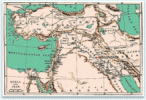 Researchers in Spain are tapping a new database in their search for historic climate patterns: medieval Arab history. Physicist Fernando Domínguez-Castro of the University of Extremadura in Badajoz, Spain, and his colleagues, including a historian of Arab culture, examined references to droughts, floods, and hail in ten Arab sources written between 816 C.E. and 1009 C.E.. One text told of nights during a Baghdad summer that were so cold that residents bundled up inside their homes rather than sleeping on roofs as was the custom, the team reported in Weather. The texts, the team concluded, suggest that 10th century Baghdad had more cold spells than it does now. That conclusion agrees with previous hemisphere-wide temperature reconstructions by climate scientists—but it’s the first time this has been demonstrated for Baghdad.
Researchers in Spain are tapping a new database in their search for historic climate patterns: medieval Arab history. Physicist Fernando Domínguez-Castro of the University of Extremadura in Badajoz, Spain, and his colleagues, including a historian of Arab culture, examined references to droughts, floods, and hail in ten Arab sources written between 816 C.E. and 1009 C.E.. One text told of nights during a Baghdad summer that were so cold that residents bundled up inside their homes rather than sleeping on roofs as was the custom, the team reported in Weather. The texts, the team concluded, suggest that 10th century Baghdad had more cold spells than it does now. That conclusion agrees with previous hemisphere-wide temperature reconstructions by climate scientists—but it’s the first time this has been demonstrated for Baghdad.
Understanding how global climate trends play out close to home is a priority for many climatologists. Yet extracting useful climate information from medieval records will require trust and cooperation between researchers with little in common. “People are reticent,” Domínguez-Castro says of the historians closest to medieval archives. “They think, ‘These crazy physicists are here to steal my job.’”
Still, the large geographic and historic span of Arab record-keeping is attracting funding from Spanish and German research organizations. Comparing historical records from German monasteries with those from Andalusian courts might also generate fresh insights. “Most climate reconstructions are from the north of the Mediterranean,” Domínguez-Castro explains. “The southern Mediterranean is climatically very interesting but also very little studied.”
This Random Sample first appeared in Science Magazine: [html] [pdf]